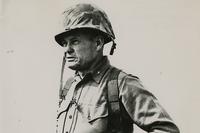Who Was Who?
"When we got there, a second group of RoK's was standing over those we'd just talked to. They were dead. At this point, I was scared and confused as to who was who."
Contributed by Athan Robinson
In 1968, the USS Pueblo was taken by the North Koreans. This incident caused the Republic of Korea (South) to go on war status.
I was a soldier with the 7th Infantry Division, 1st of the 17th Infantry (Mechanized) at Camp Kaiser, Korea. We were the furthest north of all the 7th Division units. We ran patrols around the base for a few months. Because of some prior infractions, I was transferred to the 4th of the 76th Artillery at Camp Ethan Allen [in Vermont] as punishment.
When I arrived, I was assigned to a gun pit, then to a jeep and forward observer status as we were short of officers. We were also digging bunkers along a line called Papa that would stretch all the way across Korea. I cut sod and dug bunkers with the rest of the fellas.
In January 1969, in the Pabwanee area near a village called Kumchi and Buddha-Me, we were given a patrol one day to move around the camp. Infiltrators had hit Ui-jong-bu and Seoul with grenades and machine-gun fire. The men with me hadn't been on a patrol since basic training and hadn't been on a real combat patrol at all. As we started out, it was necessary to have them pick up a basic load -- a flak vest, one M60, two boxes of ammo and two M79 grenade launchers.
We were into our second hour of the patrol when we happened upon some South Korean (RoK) soldiers taking a break during what I supposed was their patrol. We paused, talked lightly, exchanged cigarettes and started out again on our way.
A few minutes later, we heard gunfire. We locked and loaded and headed toward the gunfire thinking the RoK's might be in trouble. When we got there, a second group of RoK's was standing over those we'd just talked to. They were dead. At this point, I was scared and confused as to who was who.
A RoK officer came over to me and said, "Infiltrator." "Joe Chink," he said pointing at the dead. "Joe Chink," he said again. The officer showed me his division patch and said, "We are here." "Not them," he pointed. The dead soldiers' patches were different. He then pointed to the diamonds that distinguished rank in the South Korean Army and said, "Messed up, messed up."
As I understood it, the insignia was upside down, and one of the dead had a SKS rifle -- not South Korean issue. I was still unsure what to think and who was who. It's hard to tell when they are in the same uniform -- who is friend and who's foe.
We radioed in the incident, and we were told to let the RoK Army handle it. We left the area for our base and finished the patrol. That February, I left for the states.
I still wonder who was who and whether what I saw [was] real or what. We at least made it home. We were too small a target to take out. They had other larger, more important targets to hit. But I've always wondered about that day -- who was really who?
Want to Know More About the Military?
Be sure to get the latest news about the U.S. military, as well as critical info about how to join and all the benefits of service. Subscribe to Military.com and receive customized updates delivered straight to your inbox.















